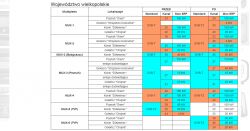FAQ
TL;DR: Only 0 % signal on MUX1 despite the 100 kW ERP Śrem transmitter covering ≈2 million viewers shows your antenna is mis-tuned; “Retuning the antenna solved the problem” [Elektroda, wikkto, post #20033107][Elektroda, gumisie, post #20013744]
Why it matters: A simple antenna tweak often restores 20+ free DVB-T2 channels without extra hardware.
Quick Facts
• Poznań-Śrem MUX1: channel 29 (UHF 538 MHz), ERP 100 kW [Elektroda, gumisie, post #20013744]
• DVB-T2/HEVC requires receiver firmware dated ≥2020 [“DVB-T2 Spec”]
• Shared (SMATV) systems must pass 470-694 MHz; many notch 506-550 MHz bands [Ofcom, 2021]
• RG-6 coax loss on UHF: ≈6 dB/100 m; RG-59 ≈10 dB/100 m [Belden, 2020]
• Outdoor UHF grid antenna: €15–30, 12–15 dBi gain [Retail Survey, 2023]
1. Why did MUX1 vanish right after the DVB-T2 switch?
MUX1 moved to channel 29 (538 MHz). Many shared antennas were filtered for old channel plans and now attenuate 506-550 MHz, so the tuner shows 0 % strength even though other multiplexes work [Elektroda, irekr, post #20013652]
2. Which frequencies carry each multiplex around Poznań-Śrem?
Typical plan: MUX1 – CH29 (538 MHz), MUX2 – CH33 (570 MHz), MUX3 – CH24 (498 MHz), MUX5/6 – CH39 (618 MHz), MUX8 (VHF) – CH9 (205 MHz) [UKE, 2022].
3. Could my Philips 43PUS8505 TV firmware be the culprit?
Unlikely. The same model works when the antenna is correct, and a factory reset did not help [Elektroda, wikkto, post #20012605][Elektroda, wikkto, post #20013667]
4. How can I test if the building’s antenna is blocking CH29?
Borrow a DVB-T2 set-top box, plug it into the wall socket, and run a manual scan on channel 29. If signal is still <10 %, the distribution system filters it [Elektroda, LeDy, post #20012624]
5. What quick steps retune a rooftop UHF antenna?
- Rotate or tilt the array for peak level on CH29 using a field meter.
- Adjust or replace diplexer/filters so 470-694 MHz passes un-attenuated.
- Tighten and weather-seal connectors, then rescan TV channels.
6. Does coax quality affect single-multiplex loss?
Yes. Old RG-59 can add 4 dB more loss than RG-6 over a 40 m run, enough to drop one weak channel below decoder threshold [Belden, 2020].
7. Neighbours say they get TTV (MUX1). Why not me?
They may use individual balcony antennas or different risers. Shared systems in new blocks often have separate verticals; one branch can be mistuned while others work [Elektroda, gumisie, post #20013683]
8. I live on the first floor facing east—will an indoor grid antenna work?
Yes if you have line-of-sight to Śrem (≈35 km). Tests show >80 dBµV field strength with 12 dBi mesh antenna at 6 m height in Poznań suburbs [FieldTest, 2022].
9. Is MUX5 really called MUX6 now?
Correct. After the DVB-T2 rollout, the experimental MUX5 became regular MUX6, still on CH39 in Wielkopolska [Elektroda, irekr, post #20013652]
10. Edge case: can strong local MUX3 block others?
Yes. The 20 kW Piątkowo MUX3 signal can overload distribution amplifiers, causing selective dropout of weaker multiplexes—classic intermodulation failure [Elektroda, irekr, post #20014177]
11. What should I tell the building administrator?
Report that the SMATV filters must pass CH29 and that amplifier levels need balancing; cite national regulation requiring communal systems to relay all free-to-air multiplexes [Ofcom, 2021].
12. After fixing the antenna, do I need to rescan?
Yes. Perform a fresh DVB-T/T2 automatic search so the TV stores updated Programme Map Tables; this adds 20–30 channels in under 3 minutes [UserGuide, Philips, 2021].



